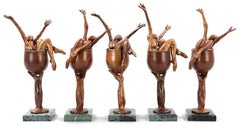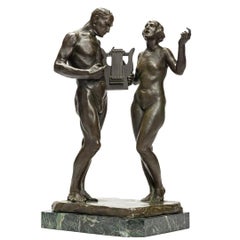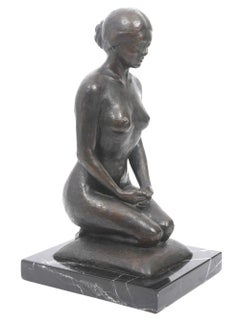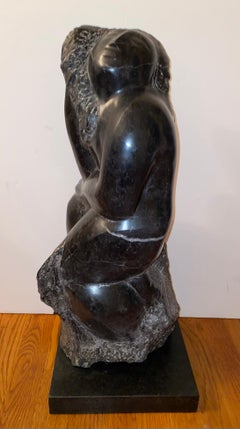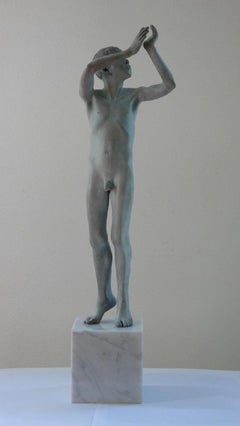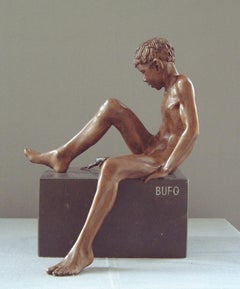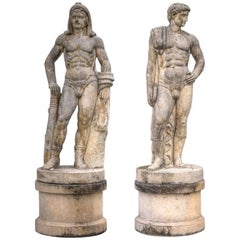Marble Nude Sculptures
to
1
5
2
2
Overall Width
to
Overall Height
to
8
1
1
3
1
1
39
9
6
2
1
1
1
3
3
2
1
1
1
1
1
1
1
35,848
51
50
17
10
1
1
1
1
1
5
4
Style: Modern
Medium: Marble
La Belle Epoque Novelle
Located in Wien, 9
John William Mills (born 4 March 1933, London) is an English sculptor.
He studied at Hammersmith School of Art, 1947–54, and at the Royal College of Art, 1956–60. He was a resident ...
Category
1970s Modern Marble Nude Sculptures
Materials
Marble, Bronze
Harmony, 20th century bronze & green marble base, nude man and woman with lyre
By Max Kalish
Located in Beachwood, OH
Max Kalish (American, 1891-1945)
Harmony, c. 1930
Bronze with green marble base
Incised signature on right upper side of base
14 x 9 x 5 inches, excluding base
17 x 10 x 8 inches, including base
Born in Poland March 1, 1891, figurative sculptor Max Kalish came to the United States in 1894, his family settling in Ohio. A talented youth, Kalish enrolled at the Cleveland Institute of Art as a fifteen-year-old, receiving a first-place award for modeling the figure during studies with Herman Matzen. Kalish went to New York City following graduation, studying with Isidore Konti...
Category
1930s American Modern Marble Nude Sculptures
Materials
Marble, Bronze
Nude Woman Figure Knelling On The Pillow
Located in Lake Worth Beach, FL
Nude woman figure knelling on the pillow.
Signed illegibly with initials, dated '64 edition 1/3.
Bronze on marble base.
Category
1960s Modern Marble Nude Sculptures
Materials
Marble, Bronze
Monumental Italian Rationalist Marble Sculptures of Young Athletes
Located in Rome, IT
This monumental pair of sculptures in "Bardiglio" marble represent Greek Athletes figure , on a cylindrical base . Exaltation of the male strength and beauty, inspired by the trend i...
Category
1960s Modern Marble Nude Sculptures
Materials
Marble
$51,576 Sale Price
20% Off
Nude
Located in Los Angeles, CA
A beautiful rendition of a seated female nude in polished and chiseled marble.
Signed and dated 1981 on the back.
Stone, wood and ceramics sculptor Lorrie Goulet, who also makes draw...
Category
1980s Modern Marble Nude Sculptures
Materials
Marble
$7,500
Monumental Italian Rationalist Marble Sculptures of Young Athletes
Located in Rome, IT
This monumental pair of sculptures in "Bardiglio" marble represent Greek Athletes figure , on a cylindrical base . Exaltation of the male strength and beauty, inspired by the trend i...
Category
1960s Modern Marble Nude Sculptures
Materials
Marble
Large Chaim Gross Mid Century Mod Bronze Sculpture Circus Acrobats WPA Artist
By Chaim Gross
Located in Surfside, FL
Chaim Gross (American, 1904-1991)
Patinated cast bronze sculpture,
Three Acrobats,
signed
mounted on black marble plinth
24.5"h x 14"w x 7"d (bronze alone)
Chaim Gross (March ...
Category
Mid-20th Century American Modern Marble Nude Sculptures
Materials
Marble, Bronze
Sydney Kumalo Bronze Minimalist African Modernist Sculpture Figural Female Nude
Located in Surfside, FL
Sydney Kumalo. Features a bronze stylized female figural form sculpture fixed to a marble plinth and wood base. Bears signature on base. Measures 9 1/2" x 4 1/4". There is no edition number on the piece.
Sydney Kumalo (1935 - 1988) was born in Sophiatown, Johannesburg, on 13 April 1935. His was one of the families who had to move out of the "white" city to the South Western Townships, or Soweto. Raised in Diepkloof and educated at Madibane High School, he took with him from old Sophiatown the curious and diverse heritage of its heyday. Art classes in the Catholic school, "Sof' town" blues and jazz, the vibrant street culture and growing defiance of its population of various races who were gradually forced out into separate race-group areas. So it was that these various aspects of his early life created for Kumalo a cultural mix of a Zulu family related to the traditional royal house; city schooling, nascent township music and lingo; growing urbanised political defiance and the deep-rooted Zulu pride and respect for the legends and ancient stories of a tribal people. This mix of old and new cultures was reinforced when he began his studies at the Polly Street Art Centre in 1953 where he became a member of Cecil Skotnes group of serious artists who were encouraged to acquire professional skills. Skotnes introduced a basic training programme with modelling as a component, which marked the introduction of sculpting (in brick-clay) at Polly Street.
Kumalo was Skotnes’ assistant at Polly Street from 1957 to 1964, and having recognised his great talent as a sculptor, Skotnes encouraged him to become a professional artist.
After Kumalo’s very successful assistance with a commission to decorate the St Peter Claver church at Seeisoville near Kroonstad, with painting designs, sculpture and relief panels in 1957, Skotnes arranged for Kumalo to continue his art training by working in Edoardo Villa ’s studio from 1958 to 1960. Working with Villa, he received professional guidance and began to familiarize himself with the technical aspects of sculpting and bronze casting. In 1960 he became an instructor at the Polly Street Art Centre.
Kumalo started exhibiting his work with some of the leading commercial Johannesburg galleries in 1958, and had his first solo exhibition with the Egon Guenther Gallery in 1962. He was a leader of the generation who managed to leave behind the forms of African curios, reject the European-held paternalism which encouraged notions of "naive" and "tribal" African art, and yet still hold fast to the core of the old legends and spiritual values of his people. He introduced these subjects into his bronze sculptures and pastel drawings, evolving his own expressive, contemporary African "style".
Together with Skotnes, Villa, Cecily Sash and Giuseppe Cattaneo, Kumalo became part of the Amadlozi group in 1963. This was a group of artists promoted by the African art collector and gallery director Egon Guenther, and characterised by their exploration of an African idiom in their art. Elza Miles writes that Cecil Skotnes’ friendship with Egon Guenther had a seminal influence on the aspirant artists of Polly Street: “Guenther broadened their experience by introducing them to German Expressionism as well as the sculptural traditions of West and Central Africa. He familiarised them with the work of Ernst Barlach, Käthe Kollwitz, Gustav Seitz, Willi Baumeister and Rudolf Sharf.” It is therefore not surprising that some of Kumalo’s sculptures show an affinity with Barlach’s powerful expressionist works. Guenther organised for the Amadlozi group to hold exhibitions around Italy, in Rome, Venice, Milan and Florence, in both 1963 and 1964.
Kumalo’s career took off in the mid 1960s, with his regular participation in exhibitions in Johannesburg, London, New York and Europe. He also represented South Africa at the Venice Biennale in 1966, and in 1967 participated in the São Paulo Biennale.
EJ De Jager (1992) describes Kumalo’s sculpture as retaining much of the “canon and formal aesthetic qualities of classical African sculpture. His work contains the same monumentality and simplicity of form.” His main medium for modelling was terra cotta, which was then cast in bronze, always paying careful attention to the finish of both the model as well as the final cast. He began casting the pieces he modelled in clay or plaster into bronze at the Renzo Vignali Artistic Foundry in Pretoria North. He worked throughout his life with its owners, the Gamberini family, and enjoyed learning the technical aspects of the casting process, refining his surfaces according to what he learned would produce the best results in metal. De Jager further writes that Kumalo’s distinctive texturing of the bronze or terra cotta is reminiscent of traditional carving techniques of various African cultures. “In many respects Kumalo thus innovated a genuine contemporary or modern indigenous South African sculpture”. Kumalo came to admire the works of the Cubists, and of British sculptors Henry Moore and Lynn Chadwick. He became noted for adapting shapes from them into his own figures. The success of his use of the then current monumental simplicity and purely aesthetic abstractions of natural forms has been emulated by many South African sculptors since the 1970s.
He was in many ways the doyen of South African Black art. As such he was an important influence especially on younger African sculptors, by whom he is greatly revered. Through his teaching at Polly Street and at the Jubilee Centre, as well as through his personal example of integrity, dedication and ability, he inspired and guided students who in their own right became outstanding artists, for example, Ezrom Legae, Leonard Matsoso and Louis Maqhubela
From 1969 onward, he allied himself with Linda Givon, founder of The Goodman Gallery in Johannesburg, where he exhibited regularly until his death in December 1988. Working with Givon also perpetuated his associations with his many friends of strong principles. Skotnes, Villa, Legae and later such peers from the Polly Street era as Leonard Matsoso, Durant Sihlali and David Koloane have all exhibited at The Goodman Gallery. Kumalo, Legae, and later Fikile (Magadlela) and Dumile (Feni) were among the leading exponents of a new Afrocentric art...
Category
20th Century Modern Marble Nude Sculptures
Materials
Marble, Bronze
"Buste Emporté", Sensual Black Marble Nude Female Bust Figurative Sculpture
Located in Clermont-Ferrand, Auvergne-Rhône-Alpes
This figurative sculpture by Lutfi Romhein depicts a female nude bust in Belgian black marble mounted on a grey marble base. It has a very fine grain which provides a really soft tou...
Category
2010s Modern Marble Nude Sculptures
Materials
Marble
Related Items
Gallulus Bronze Sculpture Nude Boy Male Figure Green Patina Marble Stone
Located in Utrecht, NL
Gallulus Bronze Sculpture Nude Boy Male Figure Green Patina Marble Stone
Wim van der Kant (1949, Kampen) is a selftaught artist. Next to his busy profess...
Category
21st Century and Contemporary Contemporary Marble Nude Sculptures
Materials
Marble, Bronze
$9,616
H 16.54 in W 7.88 in
Bufo Contemporary Bronze Sculpture Nude Boy Marble Stone Male Figure
Located in Utrecht, NL
Bufo Contemporary Bronze Sculpture Nude Boy Marble Stone Male Figure
Wim van der Kant (1949, Kampen) is a selftaught artist. Next to his busy profession as a teacher at a high school, he intensively practises his profession as a sculptor. Only when his work would measure up to his own standards, he decided to present it to the rest of the world. In 1995, he exhibited for the first time with Morren Galleries. Van der Kant desires to sculpt young people who still stand uninhibited and curiously in life. The reason he chooses to sculpt boys is, because he is one himself, this way the subject is closer to him. The anatomy of his figures testify of perfectionism. Van der Kant's subjects show similarities with the sculptures from the Greek and Roman antiquity...
Category
21st Century and Contemporary Contemporary Marble Nude Sculptures
Materials
Marble, Bronze
$10,676
H 12.21 in W 7.88 in
Aquila Bronze Sculpture Nude Boy Marble Stone Contemporary In Stock
Located in Utrecht, NL
Aquila Bronze Sculpture Nude Boy Marble Stone Contemporary In Stock - Sculpture without Stone is 57 cm high
Wim van der Kant (1949, Kampen) is a selftaught a...
Category
21st Century and Contemporary Contemporary Marble Nude Sculptures
Materials
Marble, Bronze
$16,897
H 27.56 in W 7.88 in D 7.88 in
"Pioneer Family" WPA American Modernism Plaster Maquette Realism 20th Century
Located in New York, NY
"Pioneer Family," 23 1/2 x 16 1/4 x 10 3/4 inPlaster. c. 1927. Unsigned. Realism
The Smithsonian has a cast of this sculpture in its collection. Pictured on the cover of “The Sculpt...
Category
1920s American Modern Marble Nude Sculptures
Materials
Plaster
$39,000
H 24 in W 17 in D 11 in
Woman Seated A Bronze Sculpture of a Woman by Charles Rumsey
Located in Brookville, NY
The bronze sculpture of a woman by Charles Rumsey is undated, but was created at a point in his career where he began to transition from realism to more modern, looser depictions of ...
Category
1920s American Modern Marble Nude Sculptures
Materials
Bronze
$6,000
H 10.5 in W 11 in D 6 in
Magnificent Marble Sculpture of Roman Mythological Subject Minerva 1780'
Located in Rome, IT
Finely carved mythological roman subject of Minerva in Marble Travertino . Excellent condition from an estate of Veneto.
Measurements: Statue cm 180 .
Minerva (Pallas Athena in Greek...
Category
Late 18th Century Academic Marble Nude Sculptures
Materials
Marble
$89,541
H 74.81 in W 27.56 in D 15.75 in
Aestus Bronze Sculpture Marble Stone Nude Boy Contemporary
Located in Utrecht, NL
Aestus Bronze Sculpture Marble Stone Nude Boy Contemporary
Wim van der Kant (1949, Kampen) is a selftaught artist. Next to his busy profession as a teacher ...
Category
21st Century and Contemporary Contemporary Marble Nude Sculptures
Materials
Marble, Bronze
$18,091
H 20.87 in W 3.94 in
1961 Coty Award Plaque Kenneth Hairdresser Jacqueline Onassis Bronze Fashion
Located in New York, NY
1961 Coty Award Plaque Kenneth Hairdresser Jacqueline Onassis Bronze Fashion
Bronze on wood. The wood plaque measures 12 3/4" by 20 3/4 inches. The bronze plaque itself is 13 3/4 x 8 3/4 inches and the the bronze inscription, which reads "COTY, American Fashion Critics Special Award 1961 to KENNETH of LILY DACHE...
Category
1960s American Modern Marble Nude Sculptures
Materials
Bronze
Crepis Bronze Sculpture Nude Boy Male Figure Marble Stone
Located in Utrecht, NL
Crepis Bronze Sculpture Nude Boy Male Figure Marble Stone
Wim van der Kant (1949, Kampen) is a selftaught artist. Next to his busy profession as a teacher at...
Category
21st Century and Contemporary Contemporary Marble Nude Sculptures
Materials
Marble, Bronze
$16,395
H 17.72 in W 7.88 in
19th Century Bronze Sculpture "The Letter"
Located in Rochester, NY
Antique bronze sculpture of male nude reading a letter or proclamation. Marble base, 19th century. Unsigned.
Category
Early 19th Century Marble Nude Sculptures
Materials
Marble, Bronze
19th Century Bronze of the Borghese Gladiator Sculpture
Located in Beachwood, OH
The Borghese Gladiator, 19th Century
Bronze on marble base
Musée du Louvre signed on base
15 x 12 x 8 inches
Since its discovery in the early seventeenth century, the Borghese Gladi...
Category
19th Century Marble Nude Sculptures
Materials
Marble, Bronze
Nude Female Torso Bronze Sculpture, 20th Century Contemporary American Artist
Located in Beachwood, OH
Alan Cottrill (American, Ohio, b. 1952)
Nude Female Torso, 1994
Bronze mounted to green marble base
Signed, dated and numbered 14/20 verso of leg, with foundry stamp
17. in. h. x 6 i...
Category
1990s Marble Nude Sculptures
Materials
Marble, Bronze
$2,500
H 25.5 in W 6 in D 6 in
Previously Available Items
Monumental Italian Rationalist Marble Sculptures of Hercules and Discobolo
Located in Rome, IT
This monumental pair of sculptures in "Bardiglio" marble represent Greek Athlete of Discobolo and the Hercules figure with a lion pelt, on a cylindrical base . Exaltation of the male...
Category
1960s Modern Marble Nude Sculptures
Materials
Marble
Monumental Marble Italian Rationalist Figurative Nude Sculptures
Located in Rome, IT
This monumental pair of sculptures in "Bardiglio" marble represent Greek Athlete of Discobolo and the Hercules figure with a lion pelt, on a cylindrical base...
Category
1960s Modern Marble Nude Sculptures
Materials
Marble
Large Chaim Gross Mid Century Mod Bronze Sculpture Circus Acrobats WPA Artist
By Chaim Gross
Located in Surfside, FL
Chaim Gross (American, 1904-1991)
Patinated cast bronze sculpture,
Three Acrobats,
signed
mounted on black marble plinth
24.5"h x 14"w x 7"d (bronze alone)
Chaim Gross (March 17, 1904 – May 5, 1991) was an American modernist sculptor and educator.
Gross was born to a Jewish family in Austrian Galicia, in the village of Wolowa (now known as Mezhgorye, Ukraine), in the Carpathian Mountains. In 1911, his family moved to Kolomyia (which was annexed into the Ukrainian USSR in 1939 and became part of newly independent Ukraine in 1991). When World War I ended, Gross and brother Avrom-Leib went to Budapest to join their older siblings Sarah and Pinkas. Gross applied to and was accepted by the art academy in Budapest and studied under the painter Béla Uitz, though within a year a new regime under Miklos Horthy took over and attempted to expel all Jews and foreigners from the country. After being deported from Hungary, Gross began art studies at the Kunstgewerbeschule in Vienna, Austria shortly before immigrating to the United States in 1921. Gross's studies continued in the United States at the Beaux-Arts Institute of Design, where he studied with Elie Nadelman and others, and at the Art Students League of New York, with Robert Laurent. He also attended the Educational Alliance Art School, studying under Abbo Ostrowsky, at the same time as Moses Soyer and Peter Blume.
In 1926 Gross began teaching at The Educational Alliance, and continued teaching there for the next 50 years. Louise Nevelson was among his students at the Alliance (in 1934), during the time she was transitioning from painting to sculpture. In the late 1920s and early 1930s he exhibited at the Salons of America exhibitions at the Anderson Galleries and, beginning in 1928, at the Whitney Studio Club. In 1929, Gross experimented with printmaking, and created an important group of 15 linocuts and lithographs of landscapes, New York City streets and parks, women in interiors, the circus, and vaudeville. The entire suite is now in the collection of the Philadelphia Museum of Art. Gross returned to the medium of printmaking in the 1960s, and produced approximately 200 works in the medium over the next two decades. For more than sixty years Chaim Gross's art has expressed optimistic, affirming themes, Judaica, balancing acrobats, cyclists, trapeze artists and mothers and children convey joyfulness, modernism, exuberance, love, and intimacy. This aspect of his work remained consistent with his Jewish Hasidic heritage, which teaches that only in his childlike happiness is man nearest to God.
In March 1932 Gross had his first solo exhibition at Gallery 144 in New York City. For a short time they represented Gross, as well as his friends Milton Avery, Moses Soyer, Ahron Ben-Shmuel and others.
Gross was primarily a practitioner of the direct carving method, with the majority of his work being carved from wood. Other direct carvers in early 20th-century American art include William Zorach, Jose de Creeft, and Robert Laurent. Works by Chaim Gross can be found in major museums and private collections throughout the United States, with substantial holdings (27 sculptures) at the Hirshhorn Museum and Sculpture Garden. A key work from this era, now at the Smithsonian American Art Museum, is the 1932 birds-eye maple Acrobatic Performers, which is also only one and one quarter inch thick.
In 1933 Gross joined the government's PWAP (Public Works of Art Project), which transitioned into the WPA (Works Progress Administration), which Gross worked for later in the 1930s. Under these programs Gross taught and demonstrated art, made sculptures that were placed in schools and public colleges, made work for Federal buildings including the Federal Trade Commission Building, and for the France Overseas and Finnish Buildings at the 1939 New York World's Fair. Gross was also recognized during these years with a silver medal at the Exposition universelle de 1937 in Paris, and in 1942, with a purchase prize at the Metropolitan Museum of Art's "Artists for Victory" exhibition for his wood sculpture of famed circus performer Lillian Leitzel.
In 1949 Gross sketched Chaim Weizmann, President of Israel, at several functions in New York City where Weizmann was speaking, Gross completed the bust in bronze later that year. Gross returned to Israel for three months in 1951 (the second of many trips there in the postwar years) to paint a series of 40 watercolors of life in various cities. This series was exhibited at the Jewish Museum (Manhattan) in 1953.
In the 1950s Gross began to make more bronze sculptures alongside his wood and stone pieces, and in 1957 and 1959 he traveled to Rome to work with famed bronze foundries including the Nicci foundry. At the end of the decade Gross was working primarily in bronze which allowed him to create open forms, large-scale works and of course, multiple casts. Gross's large-scale bronze The Family, donated to New York City in 1991 in honor of Mayor Ed Koch, and installed at the Bleecker Street Park at 11th street, is now a fixture of Greenwich Village. In 1959, a survey of Gross's sculpture in wood, stone, and bronze was featured in the exhibit Four American Expressionists curated by Lloyd Goodrich at the Whitney Museum of American Art, with work by Abraham Rattner, Doris Caesar, and Karl Knaths. In 1976, a selection from Gross's important collection of historic African sculpture, formed since the late 1930s, was exhibited at the Worcester Art Museum in the show The Sculptor's Eye: The African Art Collection of Mr. and Mrs. Chaim Gross. Gross was elected into the National Academy of Design as an Associate member, and became a full Academician in 1981. In 1984, he was inducted into the American Academy of Arts and Letters, with Jacob Lawrence and Lukas Foss. In the fall of 1991, Allen Ginsberg gave an important tribute to Gross at the American Academy of Arts and Letters, which is published in their Proceedings. In 1994, Forum Gallery, which now represents the Chaim Gross estate, held a memorial exhibition featuring a sixty-year survey of Gross's work.
Gross was a professor of printmaking and sculpture at both the Educational Alliance and the New School for Social Research in New York City, as well as at the Brooklyn Museum Art School, the MoMA art school, the Art Student's League and the New Art School (which Gross ran briefly with Alexander Dobkin...
Category
Mid-20th Century American Modern Marble Nude Sculptures
Materials
Marble, Bronze
H 26 in W 14.5 in D 7 in
Mid Century Expressionist Nude Male Acephale Sculpture in Bronze.
Located in Cotignac, FR
French Mid 20th Century bronze figure of a man presented on an iron 'tige' and marble base.
The sculpture is not signed but was purchased from Nice, France, in the 1970s as a work b...
Category
Mid-20th Century Modern Marble Nude Sculptures
Materials
Marble, Bronze, Iron
Lucienne, Mid 20th Century Sculpture.
Located in Cotignac, FR
French Mid Century patinated plaster statue by Joseph Rivière. Possibly a maquette for a project in bronze. The work is signed in full on the base of the plaster (see photo), partly obscured by the marble stand.
The statue is a wonderful graphic representation of a woman in acrobatic pose with stylised head and limbs. The statue presents a whole new interpretation of the subject from each angle. Rivière took much inspiration from his wife when creating his female nudes.
Stylistically the sculpture is similar in style to his work 'Gisant' of 1949.
Joseph Rivière was born in Tours on 5 April 1912. His father was Michel Rivière, a career soldier who was transferred to Bordeaux two months after the birth of his son. Joseph attended the Lycée Michel Montaigne in Bordeaux for his secondary education. He attended the École des Beaux-Arts of Bordeaux, and studied sculpture under Charles Louis Malric from 1930–33. He also studied drawing under François-Maurice Roganeau...
Category
Mid-20th Century Modern Marble Nude Sculptures
Materials
Marble
Cubist Nude Woman Wooden Sculpture on Marble Base
Located in Atlanta, GA
Stunning modernist 1950s wood sculpture, featuring a crouched woman in cubist style carving. Very nice carved movement of the body and the unusual position of the head. Mahogany wood...
Category
Mid-20th Century Modern Marble Nude Sculptures
Materials
Marble
Male Nude Grey Marble Sculptue
Located in Lake Worth Beach, FL
Male Nude Figure, dated 1991, signed gray marble sculpture.
Norma Goldberg New York artist born 1928-2005
Category
1990s American Modern Marble Nude Sculptures
Materials
Marble
Sydney Kumalo Bronze Minimalist African Modernist Sculpture Figural Female Nude
Located in Surfside, FL
Sydney Kumalo. Features a bronze stylized female figural form sculpture fixed to a marble plinth and wood base. Bears signature on base. Measures 9 1/2...
Category
20th Century Modern Marble Nude Sculptures
Materials
Marble, Bronze
Nude
Located in Los Angeles, CA
Albert Weissman
"Nude"
Marble
17 Inches tall overall.
American, c.1980s
Albert Weissman
1928-2007
Weissman was born October 29, 1928 in Brooklyn, NY.
He was mar...
Category
1980s Modern Marble Nude Sculptures
Materials
Marble
Seated Nude
Located in Los Angeles, CA
JOSEPH MARTINEK
"SEATED NUDE"
SIGNED, MARBLE
AMERICAN, C.1935
31 INCHES OVERALL, MARBLE 21 INCHES
American sculptor Joseph Martinek was born...
Category
1930s Modern Marble Nude Sculptures
Materials
Marble
Fat Female Nude Sculpture (Manner of Fernando Botero)
Located in Surfside, FL
this is a delightful nude with original patina in the manner of Botero. signed illegibly and well cast. this is a wonderful piece of Modernist art.
Category
20th Century Modern Marble Nude Sculptures
Materials
Marble, Bronze
Marble nude sculptures for sale on 1stDibs.
Find a wide variety of authentic Marble nude sculptures available on 1stDibs. While artists have worked in this medium across a range of time periods, art made with this material during the 21st Century is especially popular. If you’re looking to add nude sculptures created with this material to introduce a provocative pop of color and texture to an otherwise neutral space in your home, the works available on 1stDibs include elements of blue and other colors. There are many well-known artists whose body of work includes ceramic sculptures. Popular artists on 1stDibs associated with pieces like this include Wim van der Kant, John W. Mills, Lorenzo Vignoli, and Ryszard Piotrowski. Frequently made by artists working in the Contemporary, Modern, all of these pieces for sale are unique and many will draw the attention of guests in your home. Not every interior allows for large Marble nude sculptures, so small editions measuring 1.5 inches across are also available
Recently Viewed
View AllMore Ways To Browse
Vintage Patisserie Sign
Vintage Swan Lake Poster
Virgin And Child Russian
Virginie Demont Breton
W R Thrasher
W Rolfe
Waldemar Marszalek
Walter Henry Sweet Painting
Warhol Kimiko Powers
Warhol Lincoln Center Ticket
Wedding At Cana
William Blackman
William Dunlap
William Edward Millner
William H Clapp
William Lester Stevens Rockport In Winter
William Watson Jnr
William Yeaman
